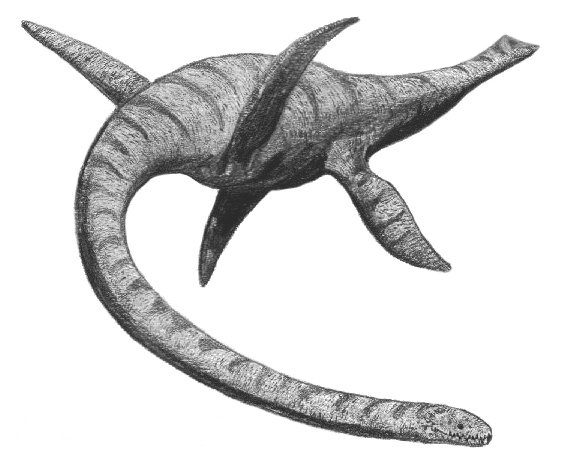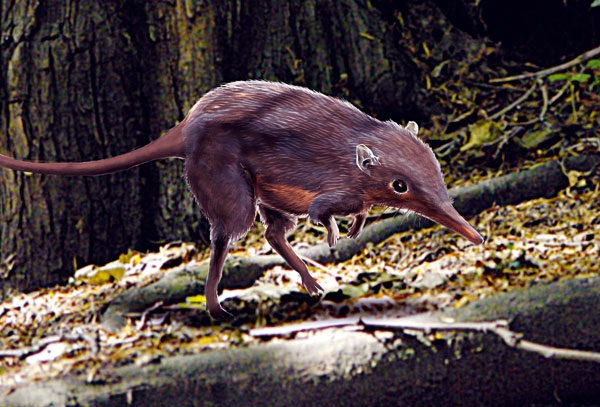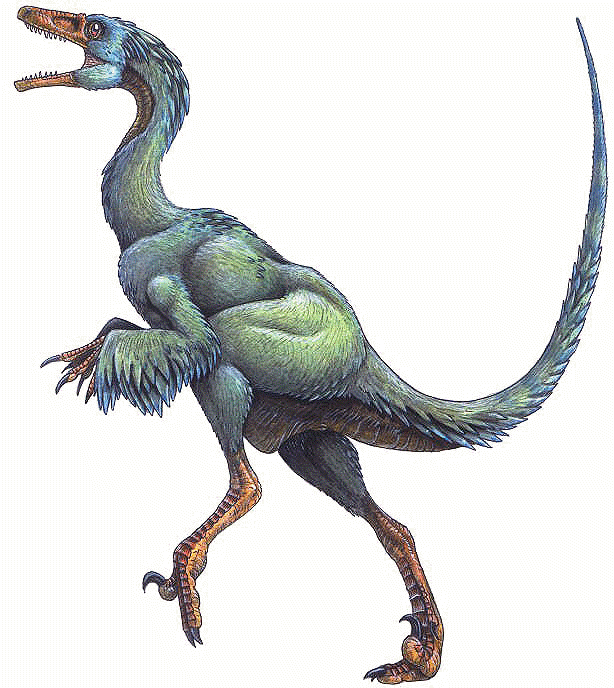You are using an out of date browser. It may not display this or other websites correctly.
You should upgrade or use an alternative browser.
You should upgrade or use an alternative browser.
What are your favorite extinct prehistoric animals?
- Thread starter Mumei
- Start date
- Status
- Not open for further replies.
Cameron122
Member
these are all the shit. You could put some of these creatures into an RPG and most folk wouldn't think that they existed.
Gonna have to get out of my dinosaur comfort zone and say the Smilodon and the Dire Wolf are favorites.
Gonna have to get out of my dinosaur comfort zone and say the Smilodon and the Dire Wolf are favorites.
The one, the only:
Archaeopteryx!
I was surprised how small this fossil really is, when i saw it in Berlin

Dinosaur Art: The World's Greatest Paleoart recently renewed my interest, and now Complete Dinosaur is on my to read list. Thanks for starting the thread Mumei.
My favourite growing up was Apatosaurus, not Brontosaurus. I also liked Euoplocephalus, (frequently mistaken for Ankylosaurus). Sauropods and ankylosaurs were my two go-to groups; I remember really disliking all the attention theropods got, what with the feathers and the bird connection. Hadrosaurs were dull and ceratopsians were too flashy. Stegosaurs just suck when I thought they petered out after the Jurassic. It's all pretty funny reflecting now back on it.
I have a particular soft spot for the Rourke series of dinosaur books, published in the late 1980's. They were unique in that they were first and foremost story books: A day in the life of _____. Growing up, most dinosaur books are pretty much fact books, full of measurements . C.M. Kozemen, one of the authors of All Yesterdays, just did a podcast talking about many popular works reducing dinosaurs to things without any sort of context. But they are not machines; they were living breathing creatures with ecological connections. The narratives of the Rourke books provide the creature and the world and utilized a variety of artists. They're obviously not accurate representations anymore, but I still love them. I actually tracked down a couple of the volumes for inspiration on a new book idea I have.
If anyone is interested in dino art and analysis, I heartily recommend a blog called Love in Time of Chasmosaurs. It's chock full of the latest findings as well as vintage paleoart. Pretty hilarious reads too.
Just bought the book, thanks
Hey, I drew that Amargasaurus picture.
Wow, small world! It came up when I put Amargasaurus into GIS, and caught my eye so I posted it here. Good job on it!
Drawing dinosaurs was what originally got me into art as a child, I should try my hand at it again.
scar tissue
Banned
Anyone got a bigger version of this?
Has anyone seen this docu with John Hurt doing the voice over on blu ray? With new evidence how they lived,how they eat etc. Such a fantastic thing to see with the technology to find out in what periode they roamed the earth. My favorite in this series is..
Spinosaurus
Spinosaurus
discopantsman
Member
I always loved the wooly mammoth... they seem so immense, so imposing and yet so cuddly all at the same time...


There is a growing consensus, from biomechanical, geochemical, and bone histological disciplines, that dinosaurs had elevated metabolisms. Whether or not they were fully in the range of mammals or their avian descendants is open to some debate, but it is highly unlikely that ecotothermy in the traditional "reptilian" sense was a viable metabolic strategy, and it's one that very few people in the field seem to be advocating these days.
The bones tell us that, physiologically, dinosaurs were doing things that living, and, as far as we can tell, extinct, reptiles simply cannot. The growth rates estimated by counting LAGs, (lines of arrested growth, which are not limited to ectotherms as once thought), in dinosaurs are elevated well above those observed in both wild and captive reptiles. It was traditionally thought that ectothermic dinosaurs could retain heat simply via their often large body sizes, and such "gigantothermy" would also show higher growth rates than the reptilian norm, but LAG-count analyses on some contemporaneous giant crocodilians, such as Deinosuchus, have shown that they grow much like their modern relatives: slowly over a long period of time. The growth profile of many dinosaurs was fundamentally different: accelerated growth early on allowed them to reach adult size, even in 30-50+ tonne sauropods, in no more than two or three decades. As far as I know, a means by which a typical ectothermic metabolism could sustain such growth rates has yet to be proposed.
Finally, (and I'm not sure how much of this was covered in The Complete Dinosaur, 2nd ed., as I haven't been able to give my copy the time it deserves), with a group as long-lived and diverse as the dinosaurs, with a range of body sizes spanning several orders of magnitude, it's not unreasonable to suppose that their metabolic rates were similarly varied, with some running "hotter" than others.
You have actually given a nice overview of the perspectives that the book spend three chapters and about 135 pages explaining.
I don't think that any of them mentioned anything about comparisons of contemporaneous giant crocodilians, however. In the ""Intermediate" Dinosaurs" chapter by R.E.H. Reid, he argues:
"Correspondingly, in assessing other studies I do not accept arguments or assertions based on actualistic assumptions that cannot be verified, like the notions that erect limbs and fast growth imply high metabolic rates. This puts me at odds with others who do rely on them, but I think that this is justified. For me, both these notions are flawed in depending on the uniformitarian view that the present is the key to the past, which, while of proven value in interpreting the physical world, is potentially misleading if applied to the anatomical features of modern evolutionary end forms. Fully erect limbs and fast growth to large sizes are now seen only in endotherms, but we do not know whether they are only possible for endotherms or first appeared in preendothermic ancestors that only now have endothermic descendants"
And I don't know much about anatomy and physiology but:
"Growth rates change with, but, in terms of age and final weight only, a T. rex grows 24 times as fast as Ferguson's C. porosus. Such contrasts indicate some major physiological differences between nonavian dinosaurs and reptiles; but they still do not tell us that such dinosaurs had high metabolic rates, because the only things we know to be needed for such growth are the right genetic makeup (genome), an adequate food intake, and digestive, respiratory, and cardiovascular systems able to supply growing tissues with the necessary substrates and energy at the rate that it requires. A high basal metabolic rate could be a further requirement; but there is currently no proof that it is, because actual metabolic rates can only be measured in live animals. Further, if there were a causal connection between fast growth and endothermy, all endotherms would have to grow quickly, which we humans do not, and the periodic fast growth of some turtles and crocodiles would not be possible."
I might be missing something, but ... wouldn't having a fast digestive rate, a need for an elevated amount of food, and digestive, respiratory, and cardiovascular systems that allow for - and demand - this greatly increased intake of food imply that said creature also had a high metabolic rate? I'm not really understanding how he's demarcating between those features to this extent. And I think his argument about humans only proves that growth of endotherms is indeed limited by genes; it doesn't seem to me to be a good argument for then arguing that such growth patterns are possible for low or moderate basal metabolic rates.
What am I missing?
Cow Mengde
Banned
I might be missing something, but ... wouldn't having a fast digestive rate, a need for an elevated amount of food, and digestive, respiratory, and cardiovascular systems that allow for - and demand - this greatly increased intake of food imply that said creature also had a high metabolic rate? I'm not really understanding how he's demarcating between those features to this extent. And I think his argument about humans only proves that growth of endotherms is indeed limited by genes; it doesn't seem to me to be a good argument for then arguing that such growth patterns are possible for low or moderate basal metabolic rates.
What am I missing?
Yeah, I found that weird too. We could always use the website Ask A Biologist to see if they can clear that up. Google the place, they have real biologists answering questions like this.
Spaceman Spiff
Member
You have actually given a nice overview of the perspectives that the book spend three chapters and about 135 pages explaining.
I don't think that any of them mentioned anything about comparisons of contemporaneous giant crocodilians, however. In the ""Intermediate" Dinosaurs" chapter by R.E.H. Reid, he argues:
"Correspondingly, in assessing other studies I do not accept arguments or assertions based on actualistic assumptions that cannot be verified, like the notions that erect limbs and fast growth imply high metabolic rates. This puts me at odds with others who do rely on them, but I think that this is justified. For me, both these notions are flawed in depending on the uniformitarian view that the present is the key to the past, which, while of proven value in interpreting the physical world, is potentially misleading if applied to the anatomical features of modern evolutionary end forms. Fully erect limbs and fast growth to large sizes are now seen only in endotherms, but we do not know whether they are only possible for endotherms or first appeared in preendothermic ancestors that only now have endothermic descendants"
I'm honestly not sure what to make of what Reid says here. Uniformitarianism has been a foundational principle of geology and paleontology, (basically any scientific discipline where direct observation is often not possible), since the 18th and 19th centuries. Without it, deep time would be an impenetrable obstacle to our understanding of, say, plate tectonics or the evolution and radiation of ancient life. There is of course a danger in reading too much from the modern world into our interpretations of the past, but no one is arguing for an absolute, strict uniformatarianism, which would dictate, among other things, that the physiologies of modern animals and the ecological niches they fill represent the full spectrum of adaptation that was present in the past as well.
Almost certainly, the thermoregulatory biology of dinosaurs was unique in certain aspects, but the presence of some combination of erect posture, rapid, sustained growth rates, avian-style air-sac respiratory systems, and feathery insulation in dinosaurs is most consistent with endothermy of some form. That these features are lacking in both living ectotherms, and those in the fossil record, does not completely preclude the possibility that dinosaurs were an exception, but nonetheless makes it rather unlikely.
And I don't know much about anatomy and physiology but:
"Growth rates change with, but, in terms of age and final weight only, a T. rex grows 24 times as fast as Ferguson's C. porosus. Such contrasts indicate some major physiological differences between nonavian dinosaurs and reptiles; but they still do not tell us that such dinosaurs had high metabolic rates, because the only things we know to be needed for such growth are the right genetic makeup (genome), an adequate food intake, and digestive, respiratory, and cardiovascular systems able to supply growing tissues with the necessary substrates and energy at the rate that it requires. A high basal metabolic rate could be a further requirement; but there is currently no proof that it is, because actual metabolic rates can only be measured in live animals. Further, if there were a causal connection between fast growth and endothermy, all endotherms would have to grow quickly, which we humans do not, and the periodic fast growth of some turtles and crocodiles would not be possible."
I might be missing something, but ... wouldn't having a fast digestive rate, a need for an elevated amount of food, and digestive, respiratory, and cardiovascular systems that allow for - and demand - this greatly increased intake of food imply that said creature also had a high metabolic rate? I'm not really understanding how he's demarcating between those features to this extent. And I think his argument about humans only proves that growth of endotherms is indeed limited by genes; it doesn't seem to me to be a good argument for then arguing that such growth patterns are possible for low or moderate basal metabolic rates.
What am I missing?
You're not missing much. I'm hardly an expert myself, but the "digestive, respiratory, and cardiovascular systems able to supply growing tissues with the necessary substrates and energy" at the rates shown by dinosaur bone histology is only compatible with an elevated metabolism, if not outright endothermy. No living ectothermic reptiles, neither in the wild nor captivity, exhibit such growth, and studies have shown that the same was true of, for example, the giant crocodilians that were contemporaries of the dinosaurs, even in the same favorably warm climates that would have allowed supposed ectothermic dinosaurs to show fast growth.
It's true that all endotherms do not grow quickly, and no one has proposed that dinosaurs were uniformly fast in their growth. Indeed, studies have shown that dinosaur species occupied a spectrum of growth rates, and the metabolisms that fueled them. These varied, in some cases, within the lifetime of individual animals. The "periodic fast growth of some turtles and crocodiles" is not necessarily evidence against a link between fast growth and endothermy, because while it is true that living reptiles can exhibit fast growth in favorable conditions, it has yet to be shown that they can do so at the rates seen in many dinosaurs.
Third Strike
Member
That giant ape posted in the first page. Infinitely more fascinating than any lizard or seacreature. Would love to see reconstructions/skeletons.
I believe only teeth have been found from the Gigantopithecus. But, their closest living relative is the orangutan, and they might have looked like an over-grown version of them:
bengraven
Member
- Triceratops/Toro and Styrakosaurus
- Brachiosaurus
- Carnotaurus/Allosaurus
- Mammoths, mastodons, and other adapted forms
- T-rex
- Deinonychus
- terror birds
- all the many awesome "savannah" creatures from North America like cheetahs, hyenas, and lions
- plesios
- prehistoric whales
- Neandertals
As a kid I adored Dimetrodon.
I just miss dinos, period. I know I'm not alone. I'm seeing a ton of "Jurassic Park" like dinosaur toys out there by Lego and Imaginext in Walmart and Target lately. You know the love is there - like the modern Western I really want to see the dinosaur genre return.
Edit:
God I love 80s and 90s prehistoric art. I used to have this massive puzzle/poster thing from the late 80s with volcanoes exploding and tons of dinosaurs that slowly evolved over time from left to right until it became sabertooth tigers and mammoths I believe. Anyway.
- Brachiosaurus
- Carnotaurus/Allosaurus
- Mammoths, mastodons, and other adapted forms
- T-rex
- Deinonychus
- terror birds
- all the many awesome "savannah" creatures from North America like cheetahs, hyenas, and lions
- plesios
- prehistoric whales
- Neandertals
As a kid I adored Dimetrodon.
I just miss dinos, period. I know I'm not alone. I'm seeing a ton of "Jurassic Park" like dinosaur toys out there by Lego and Imaginext in Walmart and Target lately. You know the love is there - like the modern Western I really want to see the dinosaur genre return.
Edit:
God I love 80s and 90s prehistoric art. I used to have this massive puzzle/poster thing from the late 80s with volcanoes exploding and tons of dinosaurs that slowly evolved over time from left to right until it became sabertooth tigers and mammoths I believe. Anyway.
Not exactly prehistoric, but it is extent. Haast's Eagle.

These motherfuckers were alive as late as the 17th century AD.
They ate large birds (large by today's standards) and sometimes human children.
Edit: Not my favorite, but not mentioned in this thread yet.

These motherfuckers were alive as late as the 17th century AD.
They ate large birds (large by today's standards) and sometimes human children.
Edit: Not my favorite, but not mentioned in this thread yet.
bengraven
Member
I'm a dinosaur guy, so I have to post some dinosaurs:

Acrocanthosaurus
These things were the biggest, baddest motherfuckers in Jurassic Park: Operation Genesis. They regularly killed my T-rexes and fed on them.
Not exactly prehistoric, but it is extent. Haast's Eagle.

These motherfuckers were alive as late as the 17th century AD.
They ate large birds (large by today's standards) and sometimes human children.
Edit: Not my favorite, but not mentioned in this thread yet.
You should read Harry Turtledove's "Atlantis" novels.
It supposes a world where there's a massive land mass to the east of the US which is actually discovered first. It's based on prehistoric New Zealand with Haast Eagle-like creatures and emu-things.
Always-honest
Banned
Some favorites right now (mainly because my 5 year old son is so enthousiastic):
- Allosaurus
- Liopleurodon
- Ankylosaurus
- Allosaurus
- Liopleurodon
- Ankylosaurus
Demoncarnotaur
Member
my new fav is Yutyrannus

Then you should appreciate this fantastic piece of art:
lastplayed
Member
Amazing thread, love these pics.
wtf, how did I now know about this? We must know more!
Gigantopithecus blacki.

How can this not capture your imagination?
wtf, how did I now know about this? We must know more!
Panthalassic
Member
Dinosaurs are cool but I really like trilobites and eurypterids! Because who doesn't love the idea of 8 foot long, predatory sea scorpions?
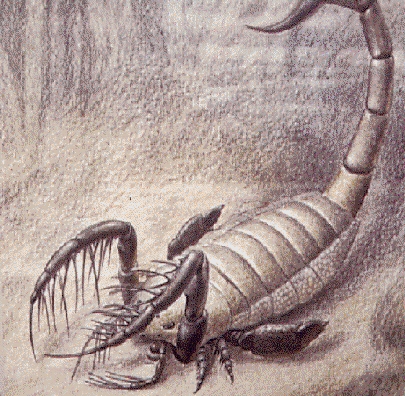
Megafauna are really cool too! Woolly mammoths, sabretooth tigers, giant sloths, etc. A shame they were just too big to survive.

Megafauna are really cool too! Woolly mammoths, sabretooth tigers, giant sloths, etc. A shame they were just too big to survive.
I'm honestly not sure what to make of what Reid says here. Uniformitarianism has been a foundational principle of geology and paleontology, (basically any scientific discipline where direct observation is often not possible), since the 18th and 19th centuries. Without it, deep time would be an impenetrable obstacle to our understanding of, say, plate tectonics or the evolution and radiation of ancient life. There is of course a danger in reading too much from the modern world into our interpretations of the past, but no one is arguing for an absolute, strict uniformatarianism, which would dictate, among other things, that the physiologies of modern animals and the ecological niches they fill represent the full spectrum of adaptation that was present in the past as well.
Almost certainly, the thermoregulatory biology of dinosaurs was unique in certain aspects, but the presence of some combination of erect posture, rapid, sustained growth rates, avian-style air-sac respiratory systems, and feathery insulation in dinosaurs is most consistent with endothermy of some form. That these features are lacking in both living ectotherms, and those in the fossil record, does not completely preclude the possibility that dinosaurs were an exception, but nonetheless makes it rather unlikely.
Well, I wouldn't want to give the impression that he is arguing for ectothermy; he's actually arguing that dinosaurs have no physiological counterparts in the modern day. I suppose his point there is that even though we have "ectotherms" and "endotherms" today with a huge gap in all sorts of things and effectively no overlap in activity levels, the fact that dinosaurs appear to share many qualities with endotherms does not necessarily mean they were necessarily endotherms. Of course, it certainly seems as if the evidence points rather strongly towards dinosaurs having been tachyaerobic endotherms, so I don't really understand how he is reconciling the evidence of their evident behavior with what he claims is the more ambivalent evidence of their physiology. I don't really get a sense of why he thinks that they were intermediates. For instance, he will argue that it is probable that dinosaurs had complete double-pump circulation. Okay. And then in the next breath he explains that this sort of circulation is today found only in endotherms - but we don't know that dinosaurs were necessarily endotherms because of this because we do not know if endothermy and this circulation evolved concurrently or one before the other and saw we cannot necessarily draw any conclusions even if a dinosaur with a birdlike heart were found preserved.
You should read those three chapters; I think you would find them very interesting.
Demoncarnotaur
Member
Neffarias_Bredd
Member
I'd imagine when Dinosaurs were roaming the Earth that massive forests were prevalent...How did they quickly navigate their massive bodies around trees and stuff when they were hunting? Did the big boys just avoid forested areas all together?
I'd imagine when Dinosaurs were roaming the Earth that massive forests were prevalent...How did they quickly navigate their massive bodies around trees and stuff when they were hunting? Did the big boys just avoid forested areas all together?
There was an interesting chapter in The Complete Dinosaur about prehistoric plants that mentioned this:
Additionally, plants are important to animals in that they define the environment within which animals live. By example, a forest forms a barrier to large animals and is difficult for them to pass through. In contrast, smaller animals perceive the forest as a three-dimensional habitat and haev the option to move vertically as well as horizontall within it. Conversely, the two-dimensional surface of an open "grassland" allows free motion of large animals but limits the options for small animals. Only by burrowing can smaller animals create a three-dimensional environment in open country. This is a common solution for mammals, but among the dinosaurs, only a few birds were small enough to effectively explore it.
Anticitizen One
Banned
Dilophosaurus

Archaeopteryx

Ankylosaurus
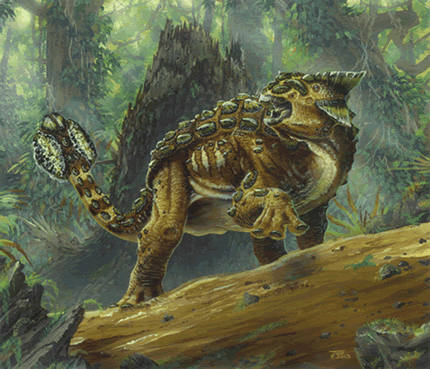

Archaeopteryx

Ankylosaurus

Baconsaurus Rex
Member
Longisquama
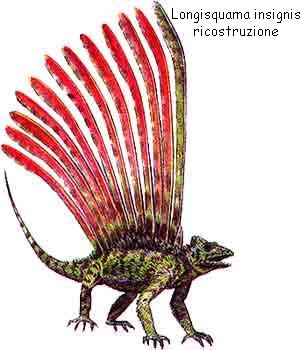
Tanystropheus

Megalania (8m long Komodo dragon)

Dunkleosteus


Tanystropheus

Megalania (8m long Komodo dragon)

Dunkleosteus

Archaeopteryx
Member
Archaeopteryx

Took the picture I was gonna use! Haha
Always been a favourite of mine.
Demoncarnotaur, thanks for that picture of the Yutyrannus Huali's - found my new desktop picture
I loved dinosaurs as a child, still do in fact. Such awesome animals, and it's hard to believe sometimes that this planet was once full of them.
It does contain a few unfortunate accuracies, though. For instance, it makes the claim that, "Despite the appeal of Tyrannosaurus, the ubiquity of Triceratops, or the stateliness of Stegosaurus, sauropods are the iconic dinosaurs." This is utter nonsense, of course.
i disagree with you on this - i believe the author(s) are right and if you'll go and ask random people on the street to paint a dinosaur for you, you'll see a sauropod much more often than a t-rex.
on topic - choosing "my favorite" was a hard task even back when i was a kid. triceratops or t-rex? or maybe raptors? i couldn't decide. so i'll vote for Megatherium this time. the Giant Sloth, just because it was a giant sloth.
There was this dinosaur who was otherwise nothing special to me, but had the longest name I've ever seen for a dinosaur - anyone care to remind me what that could be?
Micropachycephalosaurus, maybe?
Micropachycephalosaurus, maybe?
Nope, this one seems easy to break down into well known roots. The one I'm trying to remember had a weird name, that's why I forgot :/.
Green Mamba
Member
Opisthocoelicaudia?
Wait, that might be just about the most opposite thing of what you're saying.
Wait, that might be just about the most opposite thing of what you're saying.
Opisthocoelicaudia?
Wait, that might be just about the most opposite thing of what you're saying.
No, good thinking here, but it's still not it sadly.
...
On second thought, I think you were right, Mumei. It just gradually came back to my mind as I reread Micropachycephalosaurus. I thought it was a harder name because as a kid it was indeed hard for me to remember. Plus Google tells me it's the longest dinosaur name anyway. Thanks! Too bad the actual dino is an unremarkable little dude.
Gigantopithecus blacki.

How can this not capture your imagination?
Yes !

It's sad when you realize that there are hundreds of mind blowing species throughout the ages that we'll never know about because they just became extinct without leaving any traces.
Also would it be possible that intelligent sentient species of dinosaurs (or something else) appeared, built a civilization (not necessarily as advanced as ours) and became extinct somewhere during this hundreds of millions year span.
Werd Smilodon all up ins!
Green Mamba
Member
How about some prehistoric whales and whale ancestors?
Like Ambulocetus ("walking whale"), possibly some sort of terrifying mammalian crocodile like thing:
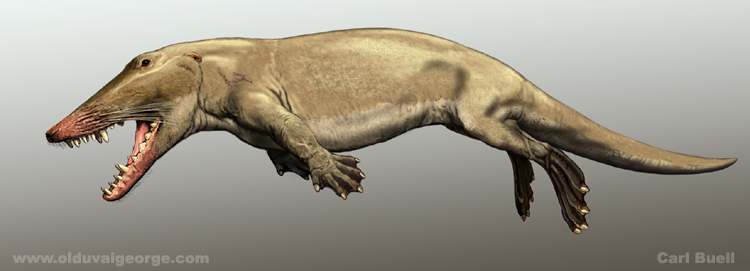
Or Aegyptocetus, first discovered as a bunch of cross sections of a skull in some quarried limestone:
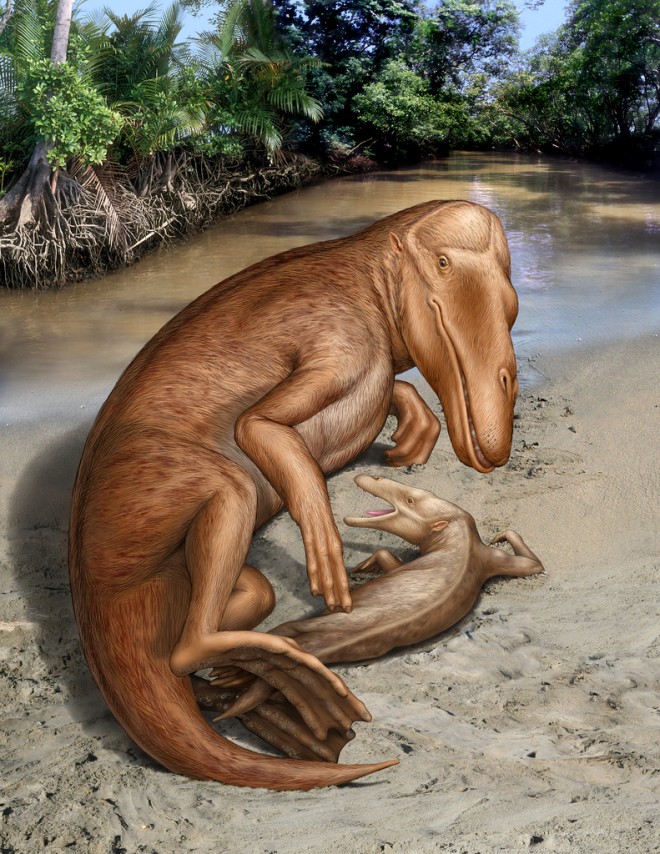
Or perhaps Basilosaurus, which roughly means "King Lizard," winner of perhaps the least fitting scientific name for any animal ever:

Like Ambulocetus ("walking whale"), possibly some sort of terrifying mammalian crocodile like thing:

Or Aegyptocetus, first discovered as a bunch of cross sections of a skull in some quarried limestone:

Or perhaps Basilosaurus, which roughly means "King Lizard," winner of perhaps the least fitting scientific name for any animal ever:

...I'm glad megalodons are extinct now.My Megalodon tooth:

...I'm glad megalodons are extinct now.
-Bruce
My Megalodon tooth:

Gimme
Spaceman Spiff / Cow Mengde:
So, I was reading Unearthing the Dragon: The Great Feathered Dinosaur Discovery by Mark Norell (Chair and Curator, Division of Paleontology, American Museum of Natural History), and he has a chapter dedicated to BAND (Birds Are Not Dinosaurs). And there's an interesting bit:
Their response to the discovery of fuzzy and feathered dinosaurs in the Liaoning deposits are not untypical of their methods. Initially, the claim was made by some of the BAND members that the "dinofuzz" of Sinosauropteryx is not a feather-like external covering, but internal structures that supported a crest, as seen in iguanas. In the words of Feduccia, "What you see is the darkened area from the nape of the neck to the tip of the tail. ... And it's almost certainly one of those lizard-like frills running down the back. It has nothing to do with feathers." Feduccia had not, of course, examined the actual specimen before commenting. Neither had Ruben, who claimed he could determine from photographs that the lung structure of Sinosauropeteryx was extremely primitive, obviating any chance that this animal was warm-blooded.
Living birds have highly modified lungs, where air flows through the lung in one direction. Often the lungs themselves invade the hollow cavities of the bones. Ventilation of the lung occurs by a rocking motion of the thoracic cavity. Unlike mammals, there is no separation of the trunk cavity by a diaphragm. Ruben's team concluded that there was a separation present in the thoracic cavity of Sinosauropteryx; therefore, it did not have an avian type of lung. Note that having an avian lung is immaterial, because avian respiration (unless specially created) had to have evolved from a more primitive system of two chambers separated by a diaphragm.
Ruben's evidence for a two-chambered body was a dark stain on the fossil, which he interpreted to be the residue of the liver. This stain seemed to have a very sharp front border, suggesting to Ruben that the body cavity was separated by a diaphragm, as in mammals and crocodiles.
It was funny when Canadian paleontologist Phil Currie (a co-author with Ji and me of feathered dinosaur papers) pointed out that the Sinosauropteryx "liver" was just a smudge of carbon and glue on a rock and that the front margin was an artifact of the way flakes of rock entombing the skeleton had split.
Living birds have highly modified lungs, where air flows through the lung in one direction. Often the lungs themselves invade the hollow cavities of the bones. Ventilation of the lung occurs by a rocking motion of the thoracic cavity. Unlike mammals, there is no separation of the trunk cavity by a diaphragm. Ruben's team concluded that there was a separation present in the thoracic cavity of Sinosauropteryx; therefore, it did not have an avian type of lung. Note that having an avian lung is immaterial, because avian respiration (unless specially created) had to have evolved from a more primitive system of two chambers separated by a diaphragm.
Ruben's evidence for a two-chambered body was a dark stain on the fossil, which he interpreted to be the residue of the liver. This stain seemed to have a very sharp front border, suggesting to Ruben that the body cavity was separated by a diaphragm, as in mammals and crocodiles.
It was funny when Canadian paleontologist Phil Currie (a co-author with Ji and me of feathered dinosaur papers) pointed out that the Sinosauropteryx "liver" was just a smudge of carbon and glue on a rock and that the front margin was an artifact of the way flakes of rock entombing the skeleton had split.
And the chapter in The Complete Dinosaur arguing that dinosaurs were ectothermal? It was written by John A. Ruben, Terry D. Jones, Nicholas R. Geist, Willem J. Hillennius, Amy E. Harwell, and Devon E. Quick. Jones is also mentioned in a later paragraph in the other book.
Hm
Spaceman Spiff
Member
Spaceman Spiff / Cow Mengde:
So, I was reading Unearthing the Dragon: The Great Feathered Dinosaur Discovery by Mark Norell (Chair and Curator, Division of Paleontology, American Museum of Natural History), and he has a chapter dedicated to BAND (Birds Are Not Dinosaurs). And there's an interesting bit:
*snip*
And the chapter in The Complete Dinosaur arguing that dinosaurs were ectothermal? It was written by John A. Ruben, Terry D. Jones, Nicholas R. Geist, Willem J. Hillennius, Amy E. Harwell, and Devon E. Quick. Jones is also mentioned in a later paragraph in the other book.
Hm
Yes, the Ruben et al. of BAND fame are the same as those suggesting that dinosaurs were metabolic "good reptiles," both hypotheses that are very much in the scientific minority. Their methods and conclusions are questionable, to put it mildly, and contradicted by numerous morphological, phylogenetic, and biomechanical analyses.
- Status
- Not open for further replies.












